1. MySql中常用工具
1.1 mysql
该mysql不是指mysql服务,而是指mysql的客户端工具。
语法 :
mysql [options] [database]
1.1.1 连接选项
参数 :
-u, --user=name 指定用户名
-p, --password[=name] 指定密码
-h, --host=name 指定服务器IP或域名
-P, --port=# 指定连接端口
示例 :
mysql -h 127.0.0.1 -P 3306 -u root -p
mysql -h127.0.0.1 -P3306 -uroot -p2143
1.1.2 执行选项
-e, --execute=name 执行SQL语句并退出
此选项可以在Mysql客户端执行SQL语句,而不用连接到MySQL数据库再执行,对于一些批处理脚本,这种方式尤其方便。
示例:
mysql -uroot -p2143 db01 -e "select * from tb_book";

1.2 mysqladmin
mysqladmin 是一个执行管理操作的客户端程序。可以用它来检查服务器的配置和当前状态、创建并删除数据库等。
可以通过 : mysqladmin --help 指令查看帮助文档
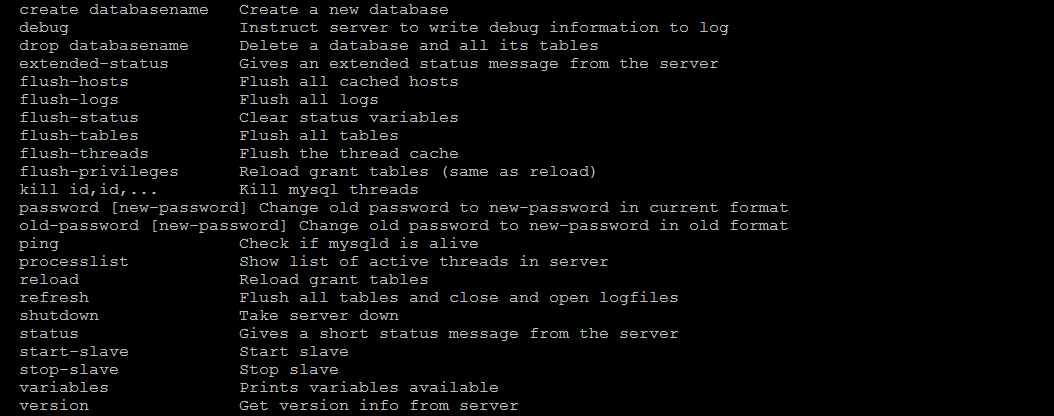
示例 :
mysqladmin -uroot -p2143 create 'test01';
mysqladmin -uroot -p2143 drop 'test01';
mysqladmin -uroot -p2143 version;
1.3 mysqlbinlog
由于服务器生成的二进制日志文件以二进制格式保存,所以如果想要检查这些文本的文本格式,就会使用到mysqlbinlog 日志管理工具。
语法 :
mysqlbinlog [options] log-files1 log-files2 ...
选项:
-d, --database=name : 指定数据库名称,只列出指定的数据库相关操作。
-o, --offset=# : 忽略掉日志中的前n行命令。
-r,--result-file=name : 将输出的文本格式日志输出到指定文件。
-s, --short-form : 显示简单格式, 省略掉一些信息。
--start-datatime=date1 --stop-datetime=date2 : 指定日期间隔内的所有日志。
--start-position=pos1 --stop-position=pos2 : 指定位置间隔内的所有日志。
1.4 mysqldump
mysqldump 客户端工具用来备份数据库或在不同数据库之间进行数据迁移。备份内容包含创建表,及插入表的SQL语句。
语法 :
mysqldump [options] db_name [tables]
mysqldump [options] --database/-B db1 [db2 db3...]
mysqldump [options] --all-databases/-A
1.4.1 连接选项
参数 :
-u, --user=name 指定用户名
-p, --password[=name] 指定密码
-h, --host=name 指定服务器IP或域名
-P, --port=# 指定连接端口
1.4.2 输出内容选项
参数:
--add-drop-database 在每个数据库创建语句前加上 Drop database 语句
--add-drop-table 在每个表创建语句前加上 Drop table 语句 , 默认开启 ; 不开启 (--skip-add-drop-table)
-n, --no-create-db 不包含数据库的创建语句
-t, --no-create-info 不包含数据表的创建语句
-d --no-data 不包含数据
-T, --tab=name 自动生成两个文件:一个.sql文件,创建表结构的语句;
一个.txt文件,数据文件,相当于select into outfile
示例 :
mysqldump -uroot -p2143 db01 tb_book --add-drop-database --add-drop-table > a
mysqldump -uroot -p2143 -T /tmp test city
1.5 mysqlimport/source
mysqlimport 是客户端数据导入工具,用来导入mysqldump 加 -T 参数后导出的文本文件。
语法:
mysqlimport [options] db_name textfile1 [textfile2...]
示例:
mysqlimport -uroot -p2143 test /tmp/city.txt
如果需要导入sql文件,可以使用mysql中的source 指令 :
source /root/tb_book.sql
1.6 mysqlshow
mysqlshow 客户端对象查找工具,用来很快地查找存在哪些数据库、数据库中的表、表中的列或者索引。
语法:
mysqlshow [options] [db_name [table_name [col_name]]]
参数:
--count 显示数据库及表的统计信息(数据库,表 均可以不指定)
-i 显示指定数据库或者指定表的状态信息
示例:
#查询每个数据库的表的数量及表中记录的数量
mysqlshow -uroot -p2143 --count
#查询test库中每个表中的字段书,及行数
mysqlshow -uroot -p2143 test --count
#查询test库中book表的详细情况
mysqlshow -uroot -p2143 test book --count
2. Mysql 日志
在任何一种数据库中,都会有各种各样的日志,记录着数据库工作的方方面面,以帮助数据库管理员追踪数据库曾经发生过的各种事件。MySQL 也不例外,在 MySQL 中,有 4 种不同的日志,分别是错误日志、二进制日志(BINLOG 日志)、查询日志和慢查询日志,这些日志记录着数据库在不同方面的踪迹。
2.1 错误日志
错误日志是 MySQL 中最重要的日志之一,它记录了当 mysqld 启动和停止时,以及服务器在运行过程中发生任何严重错误时的相关信息。当数据库出现任何故障导致无法正常使用时,可以首先查看此日志。
该日志是默认开启的 , 默认存放目录为 mysql 的数据目录(var/lib/mysql), 默认的日志文件名为 hostname.err(hostname是主机名)。
查看日志位置指令 :
show variables like 'log_error%';

查看日志内容 :
tail -f /var/lib/mysql/xaxh-server.err

2.2 二进制日志
2.2.1概述
二进制日志(BINLOG)记录了所有的 DDL(数据定义语言)语句和 DML(数据操纵语言)语句,但是不包括数据查询语句。此日志对于灾难时的数据恢复起着极其重要的作用,MySQL的主从复制, 就是通过该binlog实现的。
二进制日志,默认情况下是没有开启的,需要到MySQL的配置文件中开启,并配置MySQL日志的格式。
配置文件位置 : /usr/my.cnf
日志存放位置 : 配置时,给定了文件名但是没有指定路径,日志默认写入Mysql的数据目录。
#配置开启binlog日志, 日志的文件前缀为 mysqlbin -----> 生成的文件名如 : mysqlbin.000001,mysqlbin.000002
log_bin=mysqlbin
#配置二进制日志的格式
binlog_format=STATEMENT
2.2.2 日志格式
STATEMENT
该日志格式在日志文件中记录的都是SQL语句(statement),每一条对数据进行修改的SQL都会记录在日志文件中,通过Mysql提供的mysqlbinlog工具,可以清晰的查看到每条语句的文本。主从复制的时候,从库(slave)会将日志解析为原文本,并在从库重新执行一次。
ROW
该日志格式在日志文件中记录的是每一行的数据变更,而不是记录SQL语句。比如,执行SQL语句 : update tb_book set status=‘1’ , 如果是STATEMENT 日志格式,在日志中会记录一行SQL文件; 如果是ROW,由于是对全表进行更新,也就是每一行记录都会发生变更,ROW 格式的日志中会记录每一行的数据变更。
MIXED
这是目前MySQL默认的日志格式,即混合了STATEMENT 和 ROW两种格式。默认情况下采用STATEMENT,但是在一些特殊情况下采用ROW来进行记录。MIXED 格式能尽量利用两种模式的优点,而避开他们的缺点。
2.2.3 日志读取
由于日志以二进制方式存储,不能直接读取,需要用mysqlbinlog工具来查看,语法如下 :
mysqlbinlog log-file;
查看STATEMENT格式日志
执行插入语句 :
insert into tb_book values(null,'Lucene','2088-05-01','0');
查看日志文件 :

mysqlbin.index : 该文件是日志索引文件 , 记录日志的文件名;
mysqlbing.000001 :日志文件
查看日志内容 :
mysqlbinlog mysqlbing.000001;
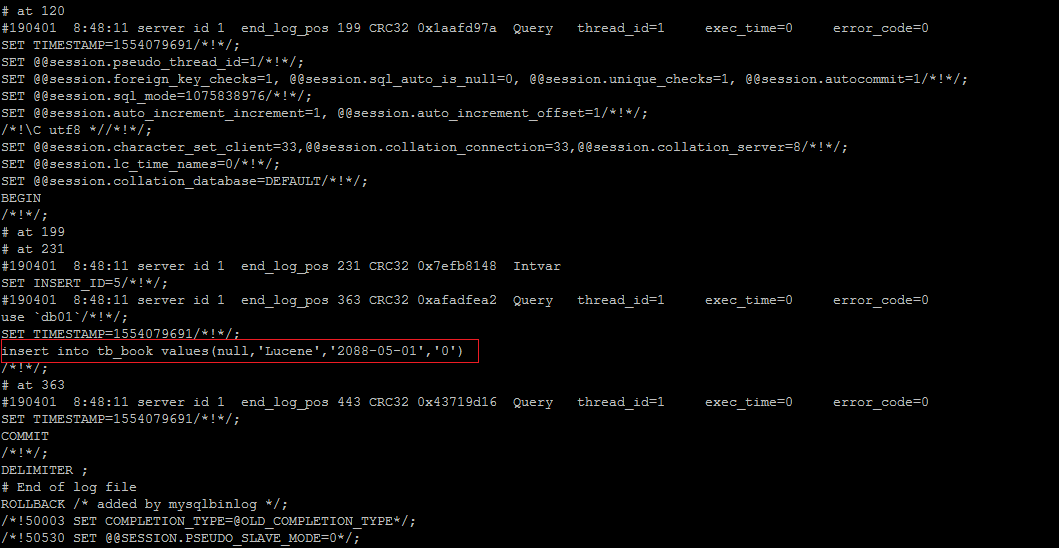
查看ROW格式日志
配置 :
#配置开启binlog日志, 日志的文件前缀为 mysqlbin -----> 生成的文件名如 : mysqlbin.000001,mysqlbin.000002
log_bin=mysqlbin
#配置二进制日志的格式
binlog_format=ROW
插入数据 :
insert into tb_book values(null,'SpringCloud实战','2088-05-05','0');
如果日志格式是 ROW , 直接查看数据 , 是查看不懂的 ; 可以在mysqlbinlog 后面加上参数 -vv
mysqlbinlog -vv mysqlbin.000002

2.2.4 日志删除
对于比较繁忙的系统,由于每天生成日志量大 ,这些日志如果长时间不清楚,将会占用大量的磁盘空间。下面我们将会讲解几种删除日志的常见方法 :
方式一
通过 Reset Master 指令删除全部 binlog 日志,删除之后,日志编号,将从 xxxx.000001重新开始 。
查询之前 ,先查询下日志文件 :

执行删除日志指令:
Reset Master
执行之后, 查看日志文件 :

方式二
执行指令 purge master logs to 'mysqlbin.******' ,该命令将删除 ****** 编号之前的所有日志。
方式三
执行指令 purge master logs before 'yyyy-mm-dd hh24:mi:ss' ,该命令将删除日志为 “yyyy-mm-dd hh24:mi:ss” 之前产生的所有日志 。
方式四
设置参数 --expire_logs_days=# ,此参数的含义是设置日志的过期天数, 过了指定的天数后日志将会被自动删除,这样将有利于减少DBA 管理日志的工作量。
配置如下 :

2.3 查询日志
查询日志中记录了客户端的所有操作语句,而二进制日志不包含查询数据的SQL语句。
默认情况下, 查询日志是未开启的。如果需要开启查询日志,可以设置以下配置 :
#该选项用来开启查询日志 , 可选值 : 0 或者 1 ; 0 代表关闭, 1 代表开启
general_log=1
#设置日志的文件名 , 如果没有指定, 默认的文件名为 host_name.log
general_log_file=file_name
在 mysql 的配置文件 /usr/my.cnf 中配置如下内容 :

配置完毕之后,在数据库执行以下操作 :
select * from tb_book;
select * from tb_book where id = 1;
update tb_book set name = 'lucene入门指南' where id = 5;
select * from tb_book where id < 8;
执行完毕之后, 再次来查询日志文件 :

2.4 慢查询日志
慢查询日志记录了所有执行时间超过参数 long_query_time 设置值并且扫描记录数不小于 min_examined_row_limit 的所有的SQL语句的日志。long_query_time 默认为 10 秒,最小为 0, 精度可以到微秒。
2.4.1 文件位置和格式
慢查询日志默认是关闭的 。可以通过两个参数来控制慢查询日志 :
# 该参数用来控制慢查询日志是否开启, 可取值: 1 和 0 , 1 代表开启, 0 代表关闭
slow_query_log=1
# 该参数用来指定慢查询日志的文件名
slow_query_log_file=slow_query.log
# 该选项用来配置查询的时间限制, 超过这个时间将认为值慢查询, 将需要进行日志记录, 默认10s
long_query_time=10
2.4.2 日志的读取
和错误日志、查询日志一样,慢查询日志记录的格式也是纯文本,可以被直接读取。
1) 查询long_query_time 的值。

2) 执行查询操作
select id, title,price,num ,status from tb_item where id = 1;

由于该语句执行时间很短,为0s , 所以不会记录在慢查询日志中。
select * from tb_item where title like '%阿尔卡特 (OT-927) 炭黑 联通3G手机 双卡双待165454%' ;

该SQL语句 , 执行时长为 26.77s ,超过10s , 所以会记录在慢查询日志文件中。
3) 查看慢查询日志文件
直接通过cat 指令查询该日志文件 :

如果慢查询日志内容很多, 直接查看文件,比较麻烦, 这个时候可以借助于mysql自带的 mysqldumpslow 工具, 来对慢查询日志进行分类汇总。

3. Mysql复制
3.1 复制概述
复制是指将主数据库的DDL 和 DML 操作通过二进制日志传到从库服务器中,然后在从库上对这些日志重新执行(也叫重做),从而使得从库和主库的数据保持同步。
MySQL支持一台主库同时向多台从库进行复制, 从库同时也可以作为其他从服务器的主库,实现链状复制。
3.2 复制原理
MySQL 的主从复制原理如下。

从上层来看,复制分成三步:
-
Master 主库在事务提交时,会把数据变更作为时间 Events 记录在二进制日志文件 Binlog 中。
-
主库推送二进制日志文件 Binlog 中的日志事件到从库的中继日志 Relay Log 。
-
slave重做中继日志中的事件,将改变反映它自己的数据。
3.3 复制优势
MySQL 复制的有点主要包含以下三个方面:
-
主库出现问题,可以快速切换到从库提供服务。
-
可以在从库上执行查询操作,从主库中更新,实现读写分离,降低主库的访问压力。
-
可以在从库中执行备份,以避免备份期间影响主库的服务。
3.4 搭建步骤
3.4.1 master
1) 在master 的配置文件(/usr/my.cnf)中,配置如下内容:
#mysql 服务ID,保证整个集群环境中唯一
server-id=1
#mysql binlog 日志的存储路径和文件名
log-bin=/var/lib/mysql/mysqlbin
#错误日志,默认已经开启
#log-err
#mysql的安装目录
#basedir
#mysql的临时目录
#tmpdir
#mysql的数据存放目录
#datadir
#是否只读,1 代表只读, 0 代表读写
read-only=0
#忽略的数据, 指不需要同步的数据库
binlog-ignore-db=mysql
#指定同步的数据库
#binlog-do-db=db01
2) 执行完毕之后,需要重启Mysql:
service mysql restart ;
3) 创建同步数据的账户,并且进行授权操作:
grant replication slave on *.* to 'itcast'@'192.168.192.131' identified by 'itcast';
flush privileges;
4) 查看master状态:
show master status;

字段含义:
File : 从哪个日志文件开始推送日志文件
Position : 从哪个位置开始推送日志
Binlog_Ignore_DB : 指定不需要同步的数据库
3.4.2 slave
1) 在 slave 端配置文件中,配置如下内容:
#mysql服务端ID,唯一
server-id=2
#指定binlog日志
log-bin=/var/lib/mysql/mysqlbin
2) 执行完毕之后,需要重启Mysql:
service mysql restart;
3) 执行如下指令 :
change master to master_host= '192.168.192.130', master_user='itcast', master_password='itcast', master_log_file='mysqlbin.000001', master_log_pos=413;
指定当前从库对应的主库的IP地址,用户名,密码,从哪个日志文件开始的那个位置开始同步推送日志。
4) 开启同步操作
start slave;
show slave status;

5) 停止同步操作
stop slave;
3.4.3 验证同步操作
1) 在主库中创建数据库,创建表,并插入数据 :
create database db01;
use db01;
create table user(
id int(11) not null auto_increment,
name varchar(50) not null,
sex varchar(1),
primary key (id)
)engine=innodb default charset=utf8;
insert into user(id,name,sex) values(null,'Tom','1');
insert into user(id,name,sex) values(null,'Trigger','0');
insert into user(id,name,sex) values(null,'Dawn','1');
2) 在从库中查询数据,进行验证 :
在从库中,可以查看到刚才创建的数据库:

在该数据库中,查询user表中的数据:

4. 综合案例
4.1 需求分析
在业务系统中,需要记录当前业务系统的访问日志,该访问日志包含:操作人,操作时间,访问类,访问方法,请求参数,请求结果,请求结果类型,请求时长 等信息。记录详细的系统访问日志,主要便于对系统中的用户请求进行追踪,并且在系统 的管理后台可以查看到用户的访问记录。
记录系统中的日志信息,可以通过Spring 框架的AOP来实现。具体的请求处理流程,如下:
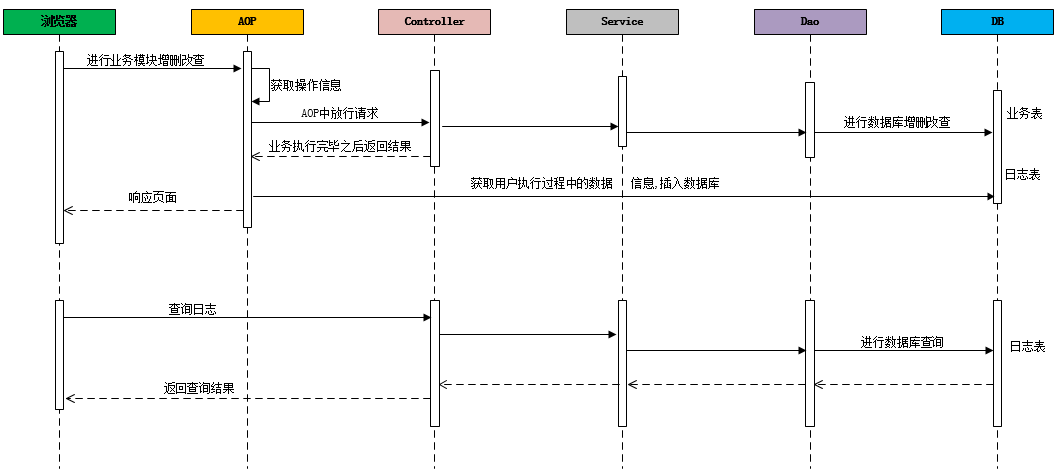
4.2 搭建案例环境
4.2.1 数据库表
CREATE DATABASE mysql_demo DEFAULT CHARACTER SET utf8mb4 ;
CREATE TABLE `brand` (
`id` bigint(20) NOT NULL AUTO_INCREMENT,
`name` varchar(255) DEFAULT NULL COMMENT '品牌名称',
`first_char` varchar(1) DEFAULT NULL COMMENT '品牌首字母',
PRIMARY KEY (`id`)
) ENGINE=InnoDB DEFAULT CHARSET=utf8;
CREATE TABLE `item` (
`id` int(11) NOT NULL AUTO_INCREMENT COMMENT '商品id',
`title` varchar(100) NOT NULL COMMENT '商品标题',
`price` double(10,2) NOT NULL COMMENT '商品价格,单位为:元',
`num` int(10) NOT NULL COMMENT '库存数量',
`categoryid` bigint(10) NOT NULL COMMENT '所属类目,叶子类目',
`status` varchar(1) DEFAULT NULL COMMENT '商品状态,1-正常,2-下架,3-删除',
`sellerid` varchar(50) DEFAULT NULL COMMENT '商家ID',
`createtime` datetime DEFAULT NULL COMMENT '创建时间',
`updatetime` datetime DEFAULT NULL COMMENT '更新时间',
PRIMARY KEY (`id`)
) ENGINE=InnoDB DEFAULT CHARSET=utf8 COMMENT='商品表';
CREATE TABLE `user` (
`id` int(11) NOT NULL AUTO_INCREMENT,
`username` varchar(45) NOT NULL,
`password` varchar(96) NOT NULL,
`name` varchar(45) NOT NULL,
`birthday` datetime DEFAULT NULL,
`sex` char(1) DEFAULT NULL,
`email` varchar(45) DEFAULT NULL,
`phone` varchar(45) DEFAULT NULL,
`qq` varchar(32) DEFAULT NULL,
PRIMARY KEY (`id`)
) ENGINE=InnoDB DEFAULT CHARSET=utf8;
CREATE TABLE `operation_log` (
`id` bigint(20) NOT NULL AUTO_INCREMENT COMMENT 'ID',
`operate_class` varchar(200) DEFAULT NULL COMMENT '操作类',
`operate_method` varchar(200) DEFAULT NULL COMMENT '操作方法',
`return_class` varchar(200) DEFAULT NULL COMMENT '返回值类型',
`operate_user` varchar(20) DEFAULT NULL COMMENT '操作用户',
`operate_time` varchar(20) DEFAULT NULL COMMENT '操作时间',
`param_and_value` varchar(500) DEFAULT NULL COMMENT '请求参数名及参数值',
`cost_time` bigint(20) DEFAULT NULL COMMENT '执行方法耗时, 单位 ms',
`return_value` varchar(200) DEFAULT NULL COMMENT '返回值',
PRIMARY KEY (`id`)
) ENGINE=InnoDB DEFAULT CHARSET=utf8mb4;
4.2.2 pom.xml
<properties>
<project.build.sourceEncoding>UTF-8</project.build.sourceEncoding>
<maven.compiler.source>1.7</maven.compiler.source>
<maven.compiler.target>1.7</maven.compiler.target>
<project.build.sourceEncoding>UTF-8</project.build.sourceEncoding>
<maven.compiler.source>1.8</maven.compiler.source>
<maven.compiler.target>1.8</maven.compiler.target>
<spring.version>5.0.2.RELEASE</spring.version>
<slf4j.version>1.6.6</slf4j.version>
<log4j.version>1.2.12</log4j.version>
<mybatis.version>3.4.5</mybatis.version>
</properties>
<dependencies> <!-- spring -->
<dependency>
<groupId>org.aspectj</groupId>
<artifactId>aspectjweaver</artifactId>
<version>1.6.8</version>
</dependency>
<dependency>
<groupId>org.projectlombok</groupId>
<artifactId>lombok</artifactId>
<version>1.16.16</version>
</dependency>
<dependency>
<groupId>org.springframework</groupId>
<artifactId>spring-context</artifactId>
<version>${spring.version}</version>
</dependency>
<dependency>
<groupId>org.springframework</groupId>
<artifactId>spring-context-support</artifactId>
<version>${spring.version}</version>
</dependency>
<dependency>
<groupId>org.springframework</groupId>
<artifactId>spring-orm</artifactId>
<version>${spring.version}</version>
</dependency>
<dependency>
<groupId>org.springframework</groupId>
<artifactId>spring-test</artifactId>
<version>${spring.version}</version>
</dependency>
<dependency>
<groupId>org.springframework</groupId>
<artifactId>spring-webmvc</artifactId>
<version>${spring.version}</version>
</dependency>
<dependency>
<groupId>org.springframework</groupId>
<artifactId>spring-tx</artifactId>
<version>${spring.version}</version>
</dependency>
<dependency>
<groupId>junit</groupId>
<artifactId>junit</artifactId>
<version>4.12</version>
<scope>test</scope>
</dependency>
<dependency>
<groupId>javax.servlet</groupId>
<artifactId>javax.servlet-api</artifactId>
<version>3.1.0</version>
<scope>provided</scope>
</dependency>
<dependency>
<groupId>javax.servlet.jsp</groupId>
<artifactId>jsp-api</artifactId>
<version>2.0</version>
<scope>provided</scope>
</dependency>
<dependency>
<groupId>log4j</groupId>
<artifactId>log4j</artifactId>
<version>${log4j.version}</version>
</dependency>
<dependency>
<groupId>org.mybatis</groupId>
<artifactId>mybatis</artifactId>
<version>${mybatis.version}</version>
</dependency>
<dependency>
<groupId>org.mybatis</groupId>
<artifactId>mybatis-spring</artifactId>
<version>1.3.0</version>
</dependency>
<dependency>
<groupId>c3p0</groupId>
<artifactId>c3p0</artifactId>
<version>0.9.1.2</version>
</dependency>
<dependency>
<groupId>mysql</groupId>
<artifactId>mysql-connector-java</artifactId>
<version>5.1.5</version>
</dependency>
<dependency>
<groupId>com.fasterxml.jackson.core</groupId>
<artifactId>jackson-core</artifactId>
<version>2.9.0</version>
</dependency>
<dependency>
<groupId>com.fasterxml.jackson.core</groupId>
<artifactId>jackson-databind</artifactId>
<version>2.9.0</version>
</dependency>
<dependency>
<groupId>com.fasterxml.jackson.core</groupId>
<artifactId>jackson-annotations</artifactId>
<version>2.9.0</version>
</dependency>
</dependencies>
<build>
<plugins>
<plugin>
<groupId>org.apache.tomcat.maven</groupId>
<artifactId>tomcat7-maven-plugin</artifactId>
<version>2.2</version>
<configuration>
<port>8080</port>
<path>/</path>
<uriEncoding>utf-8</uriEncoding>
</configuration>
</plugin>
</plugins>
</build>
4.2.3 web.xml
<?xml version="1.0" encoding="UTF-8"?>
<web-app xmlns:xsi="http://www.w3.org/2001/XMLSchema-instance" xmlns="http://java.sun.com/xml/ns/javaee"
xsi:schemaLocation="http://java.sun.com/xml/ns/javaee http://java.sun.com/xml/ns/javaee/web-app_2_5.xsd"
version="2.5">
<!-- 解决post乱码 -->
<filter>
<filter-name>CharacterEncodingFilter</filter-name>
<filter-class>org.springframework.web.filter.CharacterEncodingFilter</filter-class>
<init-param>
<param-name>encoding</param-name>
<param-value>utf-8</param-value>
</init-param>
<init-param>
<param-name>forceEncoding</param-name>
<param-value>true</param-value>
</init-param>
</filter>
<filter-mapping>
<filter-name>CharacterEncodingFilter</filter-name>
<url-pattern>/*</url-pattern>
</filter-mapping>
<context-param>
<param-name>contextConfigLocation</param-name>
<param-value>classpath:applicationContext.xml</param-value>
</context-param>
<listener>
<listener-class>org.springframework.web.context.ContextLoaderListener</listener-class>
</listener>
<servlet>
<servlet-name>springmvc</servlet-name>
<servlet-class>org.springframework.web.servlet.DispatcherServlet</servlet-class>
<!-- 指定加载的配置文件 ,通过参数contextConfigLocation加载-->
<init-param>
<param-name>contextConfigLocation</param-name>
<param-value>classpath:springmvc.xml</param-value>
</init-param>
</servlet>
<servlet-mapping>
<servlet-name>springmvc</servlet-name>
<url-pattern>*.do</url-pattern>
</servlet-mapping>
<welcome-file-list>
<welcome-file>log-datalist.html</welcome-file>
</welcome-file-list>
</web-app>
4.2.4 db.properties
jdbc.driver=com.mysql.jdbc.Driver
jdbc.url=jdbc:mysql://192.168.142.128:3306/mysql_demo
jdbc.username=root
jdbc.password=itcast
4.2.5 applicationContext.xml
<?xml version="1.0" encoding="UTF-8"?>
<beans xmlns="http://www.springframework.org/schema/beans"
xmlns:xsi="http://www.w3.org/2001/XMLSchema-instance"
xmlns:aop="http://www.springframework.org/schema/aop"
xmlns:tx="http://www.springframework.org/schema/tx"
xmlns:context="http://www.springframework.org/schema/context"
xsi:schemaLocation="http://www.springframework.org/schema/beans http://www.springframework.org/schema/beans/spring-beans.xsd
http://www.springframework.org/schema/tx http://www.springframework.org/schema/tx/spring-tx.xsd
http://www.springframework.org/schema/aop http://www.springframework.org/schema/aop/spring-aop.xsd
http://www.springframework.org/schema/context http://www.springframework.org/schema/context/spring-context.xsd">
<!-- 加载配置文件 -->
<context:property-placeholder location="classpath:db.properties"/>
<!-- 配置 spring 创建容器时要扫描的包 -->
<context:component-scan base-package="cn.itcast">
<context:exclude-filter type="annotation" expression="org.springframework.stereotype.Controller">
</context:exclude-filter>
</context:component-scan>
<!-- 配置 MyBatis 的 Session 工厂 -->
<bean id="sqlSessionFactory" class="org.mybatis.spring.SqlSessionFactoryBean">
<property name="dataSource" ref="dataSource"/>
<property name="typeAliasesPackage" value="cn.itcast.pojo"/>
</bean>
<!-- 配置数据源 -->
<bean id="dataSource" class="com.mchange.v2.c3p0.ComboPooledDataSource">
<property name="driverClass" value="${jdbc.driver}"></property>
<property name="jdbcUrl" value="${jdbc.url}"></property>
<property name="user" value="${jdbc.username}"></property>
<property name="password" value="${jdbc.password}"></property>
</bean>
<!-- 配置 Mapper 扫描器 -->
<bean class="org.mybatis.spring.mapper.MapperScannerConfigurer">
<property name="basePackage" value="cn.itcast.mapper"/>
</bean>
<!-- 配置事务管理器 -->
<bean id="transactionManager" class="org.springframework.jdbc.datasource.DataSourceTransactionManager">
<property name="dataSource" ref="dataSource"/>
</bean>
<!-- 配置事务的注解驱动 -->
<tx:annotation-driven transaction-manager="transactionManager"></tx:annotation-driven>
</beans>
4.2.6 springmvc.xml
<?xml version="1.0" encoding="UTF-8"?>
<beans xmlns="http://www.springframework.org/schema/beans"
xmlns:mvc="http://www.springframework.org/schema/mvc"
xmlns:context="http://www.springframework.org/schema/context"
xmlns:aop="http://www.springframework.org/schema/aop"
xmlns:xsi="http://www.w3.org/2001/XMLSchema-instance"
xsi:schemaLocation="http://www.springframework.org/schema/beans
http://www.springframework.org/schema/beans/spring-beans.xsd
http://www.springframework.org/schema/mvc
http://www.springframework.org/schema/mvc/spring-mvc.xsd
http://www.springframework.org/schema/aop
http://www.springframework.org/schema/aop/spring-aop.xsd
http://www.springframework.org/schema/context
http://www.springframework.org/schema/context/spring-context.xsd">
<context:component-scan base-package="cn.itcast.controller"></context:component-scan>
<mvc:annotation-driven></mvc:annotation-driven>
<aop:aspectj-autoproxy />
</beans>
4.2.7 导入基础工程
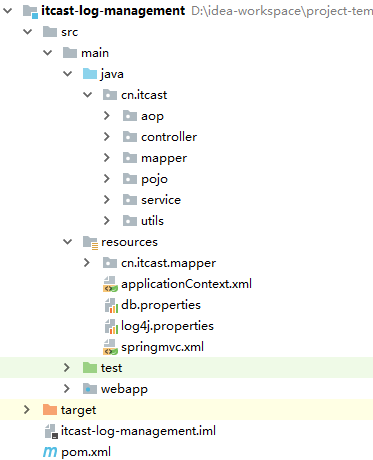
4.3 通过AOP记录操作日志
4.3.1 自定义注解
通过自定义注解,来标示方法需不需要进行记录日志,如果该方法在访问时需要记录日志,则在该方法上标示该注解既可。
@Inherited
@Documented
@Target(ElementType.METHOD)
@Retention(RetentionPolicy.RUNTIME)
public @interface OperateLog {
}
4.3.2 定义通知类
@Component
@Aspect
public class OperateAdvice {
private static Logger log = Logger.getLogger(OperateAdvice.class);
@Autowired
private OperationLogService operationLogService;
@Around("execution(* cn.itcast.controller.*.*(..)) && @annotation(operateLog)")
public Object insertLogAround(ProceedingJoinPoint pjp , OperateLog operateLog) throws Throwable{
System.out.println(" ************************ 记录日志 [start] ****************************** ");
OperationLog op = new OperationLog();
DateFormat sdf = new SimpleDateFormat("yyyy-MM-dd HH:mm:ss");
op.setOperateTime(sdf.format(new Date()));
op.setOperateUser(DataUtils.getRandStr(8));
op.setOperateClass(pjp.getTarget().getClass().getName());
op.setOperateMethod(pjp.getSignature().getName());
//获取方法调用时传递的参数
Object[] args = pjp.getArgs();
op.setParamAndValue(Arrays.toString(args));
long start_time = System.currentTimeMillis();
//放行
Object object = pjp.proceed();
long end_time = System.currentTimeMillis();
op.setCostTime(end_time - start_time);
if(object != null){
op.setReturnClass(object.getClass().getName());
op.setReturnValue(object.toString());
}else{
op.setReturnClass("java.lang.Object");
op.setParamAndValue("void");
}
log.error(JsonUtils.obj2JsonString(op));
operationLogService.insert(op);
System.out.println(" ************************** 记录日志 [end] *************************** ");
return object;
}
}
4.3.3 方法上加注解
在需要记录日志的方法上加上注解@OperateLog。
@OperateLog
@RequestMapping("/insert")
public Result insert(@RequestBody Brand brand){
try {
brandService.insert(brand);
return new Result(true,"操作成功");
} catch (Exception e) {
e.printStackTrace();
return new Result(false,"操作失败");
}
}
4.4 日志查询后端代码实现
4.4.1 Mapper接口
public interface OperationLogMapper {
public void insert(OperationLog operationLog);
public List<OperationLog> selectListByCondition(Map dataMap);
public Long countByCondition(Map dataMap);
}
4.4.2 Mapper.xml 映射配置文件
<?xml version="1.0" encoding="UTF-8" ?>
<!DOCTYPE mapper PUBLIC "-//mybatis.org//DTD Mapper 3.0//EN" "http://mybatis.org/dtd/mybatis-3-mapper.dtd" >
<mapper namespace="cn.itcast.mapper.OperationLogMapper" >
<insert id="insert" parameterType="operationLog">
INSERT INTO operation_log(id,return_value,return_class,operate_user,operate_time,param_and_value,
operate_class,operate_method,cost_time)
VALUES(NULL,#{returnValue},#{returnClass},#{operateUser},#{operateTime},#{paramAndValue},
#{operateClass},#{operateMethod},#{costTime})
</insert>
<select id="selectListByCondition" parameterType="map" resultType="operationLog">
select
id ,
operate_class as operateClass ,
operate_method as operateMethod,
return_class as returnClass,
operate_user as operateUser,
operate_time as operateTime,
param_and_value as paramAndValue,
cost_time as costTime,
return_value as returnValue
from operation_log
<include refid="oplog_where"/>
limit #{start},#{size}
</select>
<select id="countByCondition" resultType="long" parameterType="map">
select count(*) from operation_log
<include refid="oplog_where"/>
</select>
<sql id="oplog_where">
<where>
<if test="operateClass != null and operateClass != '' ">
and operate_class = #{operateClass}
</if>
<if test="operateMethod != null and operateMethod != '' ">
and operate_method = #{operateMethod}
</if>
<if test="returnClass != null and returnClass != '' ">
and return_class = #{returnClass}
</if>
<if test="costTime != null">
and cost_time = #{costTime}
</if>
</where>
</sql>
</mapper>
4.4.3 Service
@Service
@Transactional
public class OperationLogService {
//private static Logger logger = Logger.getLogger(OperationLogService.class);
@Autowired
private OperationLogMapper operationLogMapper;
//插入数据
public void insert(OperationLog operationLog){
operationLogMapper.insert(operationLog);
}
//根据条件查询
public PageResult selectListByCondition(Map dataMap, Integer pageNum , Integer pageSize){
if(paramMap ==null){
paramMap = new HashMap();
}
paramMap.put("start" , (pageNum-1)*rows);
paramMap.put("rows",rows);
Object costTime = paramMap.get("costTime");
if(costTime != null){
if("".equals(costTime.toString())){
paramMap.put("costTime",null);
}else{
paramMap.put("costTime",new Long(paramMap.get("costTime").toString()));
}
}
System.out.println(dataMap);
long countStart = System.currentTimeMillis();
Long count = operationLogMapper.countByCondition(dataMap);
long countEnd = System.currentTimeMillis();
System.out.println("Count Cost Time : " + (countEnd-countStart)+" ms");
List<OperationLog> list = operationLogMapper.selectListByCondition(dataMap);
long queryEnd = System.currentTimeMillis();
System.out.println("Query Cost Time : " + (queryEnd-countEnd)+" ms");
return new PageResult(count,list);
}
}
4.4.4 Controller
@RestController
@RequestMapping("/operationLog")
public class OperationLogController {
@Autowired
private OperationLogService operationLogService;
@RequestMapping("/findList")
public PageResult findList(@RequestBody Map dataMap, Integer pageNum , Integer pageSize){
PageResult page = operationLogService.selectListByCondition(dataMap, pageNum, pageSize);
return page;
}
}
4.5 日志查询前端代码实现
前端代码使用 BootStrap + AdminLTE 进行布局, 使用Vuejs 进行视图层展示。
4.5.1 js
<script>
var vm = new Vue({
el: '#app',
data: {
dataList:[],
searchEntity:{
operateClass:'',
operateMethod:'',
returnClass:'',
costTime:''
},
page: 1, //显示的是哪一页
pageSize: 10, //每一页显示的数据条数
total: 150, //记录总数
maxPage:8 //最大页数
},
methods: {
pageHandler: function (page) {
this.page = page;
this.search();
},
search: function () {
var _this = this;
this.showLoading();
axios.post('/operationLog/findList.do?pageNum=' + _this.page + "&pageSize=" + _this.pageSize, _this.searchEntity).then(function (response) {
if (response) {
_this.dataList = response.data.dataList;
_this.total = response.data.total;
_this.hideLoading();
}
})
},
showLoading: function () {
$('#loadingModal').modal({backdrop: 'static', keyboard: false});
},
hideLoading: function () {
$('#loadingModal').modal('hide');
},
},
created:function(){
this.pageHandler(1);
}
});
</script>
4.5.2 列表数据展示
<tr v-for="item in dataList">
<td><input name="ids" type="checkbox"></td>
<td>{{item.id}}</td>
<td>{{item.operateClass}}</td>
<td>{{item.operateMethod}}</td>
<td>{{item.returnClass}}</td>
<td>{{item.returnValue}}</td>
<td>{{item.operateUser}}</td>
<td>{{item.operateTime}}</td>
<td>{{item.costTime}}</td>
<td class="text-center">
<button type="button" class="btn bg-olive btn-xs">详情</button>
<button type="button" class="btn bg-olive btn-xs">删除</button>
</td>
</tr>
4.5.3 分页插件
<div class="wrap" id="wrap">
<zpagenav v-bind:page="page" v-bind:page-size="pageSize" v-bind:total="total"
v-bind:max-page="maxPage" v-on:pagehandler="pageHandler">
</zpagenav>
</div>
4.6 联调测试
可以通过postman来访问业务系统,再查看数据库中的日志信息,验证能不能将用户的访问日志记录下来。
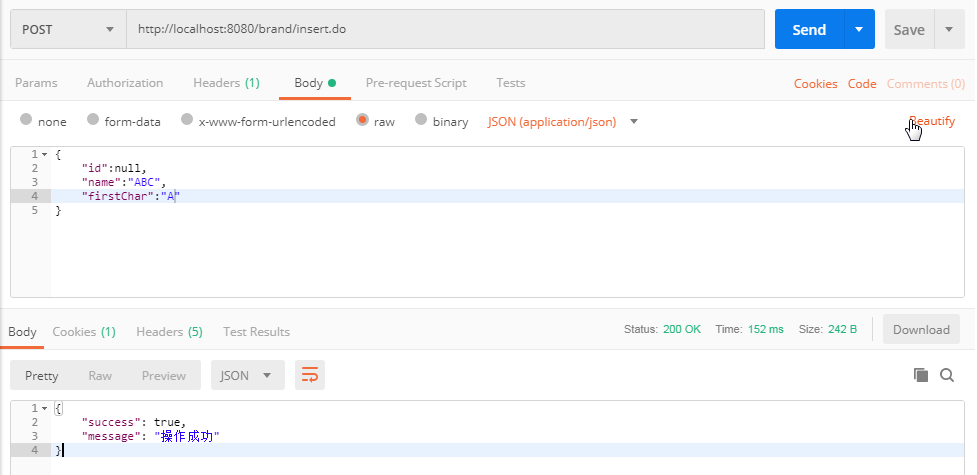
4.7 分析性能问题
系统中用户访问日志的数据量,随着时间的推移,这张表的数据量会越来越大,因此我们需要根据业务需求,来对日志查询模块的性能进行优化。
1) 分页查询优化
由于在进行日志查询时,是进行分页查询,那也就意味着,在查看时,至少需要查询两次:
A. 查询符合条件的总记录数。–> count 操作
B. 查询符合条件的列表数据。–> 分页查询 limit 操作
通常来说,count() 都需要扫描大量的行(意味着需要访问大量的数据)才能获得精确的结果,因此是很难对该SQL进行优化操作的。如果需要对count进行优化,可以采用另外一种思路,可以增加汇总表,或者redis缓存来专门记录该表对应的记录数,这样的话,就可以很轻松的实现汇总数据的查询,而且效率很高,但是这种统计并不能保证百分之百的准确 。对于数据库的操作,“快速、精确、实现简单”,三者永远只能满足其二,必须舍掉其中一个。
2) 条件查询优化
针对于条件查询,需要对查询条件,及排序字段建立索引。
3) 读写分离
通过主从复制集群,来完成读写分离,使写操作走主节点, 而读操作,走从节点。
4) MySQL服务器优化
5) 应用优化
4.8 性能优化 - 分页
4.8.1 优化count
创建一张表用来记录日志表的总数据量:
create table log_counter(
logcount bigint not null
)engine = innodb default CHARSET = utf8;
在每次插入数据之后,更新该表 :
<update id="updateLogCounter" >
update log_counter set logcount = logcount + 1
</update>
在进行分页查询时, 获取总记录数,从该表中查询既可。
<select id="countLogFromCounter" resultType="long">
select logcount from log_counter limit 1
</select>
4.8.2 优化 limit
在进行分页时,一般通过创建覆盖索引,能够比较好的提高性能。一个非常常见,而又非常头疼的分页场景就是 “limit 1000000,10” ,此时MySQL需要搜索出前1000010 条记录后,仅仅需要返回第 1000001 到 1000010 条记录,前1000000 记录会被抛弃,查询代价非常大。

当点击比较靠后的页码时,就会出现这个问题,查询效率非常慢。
优化SQL:
select * from operation_log limit 3000000 , 10;
将上述SQL优化为 :
select * from operation_log t , (select id from operation_log order by id limit 3000000,10) b where t.id = b.id ;
<select id="selectListByCondition" parameterType="map" resultType="operationLog">
select
id ,
operate_class as operateClass ,
operate_method as operateMethod,
return_class as returnClass,
operate_user as operateUser,
operate_time as operateTime,
param_and_value as paramAndValue,
cost_time as costTime,
return_value as returnValue
from operation_log t,
(select id from operation_log
<where>
<include refid="oplog_where"/>
</where>
order by id limit #{start},#{rows}) b where t.id = b.id
</select>
4.9 性能优化 - 索引

当根据操作人进行查询时, 查询的效率很低,耗时比较长。原因就是因为在创建数据库表结构时,并没有针对于 操作人 字段建立索引。
CREATE INDEX idx_user_method_return_cost ON operation_log(operate_user,operate_method,return_class,cost_time);
同上 , 为了查询效率高,我们也需要对 操作方法、返回值类型、操作耗时 等字段进行创建索引,以提高查询效率。
CREATE INDEX idx_optlog_method_return_cost ON operation_log(operate_method,return_class,cost_time);
CREATE INDEX idx_optlog_return_cost ON operation_log(return_class,cost_time);
CREATE INDEX idx_optlog_cost ON operation_log(cost_time);
4.10 性能优化 - 排序
在查询数据时,如果业务需求中需要我们对结果内容进行了排序处理 , 这个时候,我们还需要对排序的字段建立适当的索引, 来提高排序的效率 。
4.11 性能优化 - 读写分离
4.11.1 概述
在Mysql主从复制的基础上,可以使用读写分离来降低单台Mysql节点的压力,从而来提高访问效率,读写分离的架构如下:
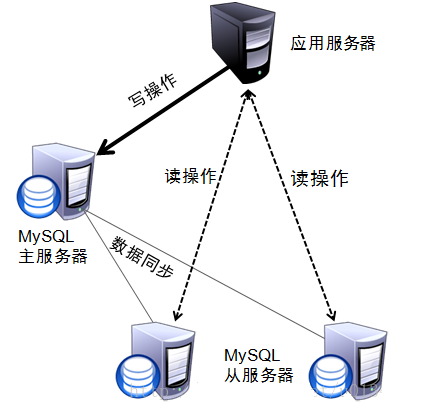
对于读写分离的实现,可以通过Spring AOP 来进行动态的切换数据源,进行操作 :
4.11.2 实现方式
db.properties
jdbc.write.driver=com.mysql.jdbc.Driver
jdbc.write.url=jdbc:mysql://192.168.142.128:3306/mysql_demo
jdbc.write.username=root
jdbc.write.password=itcast
jdbc.read.driver=com.mysql.jdbc.Driver
jdbc.read.url=jdbc:mysql://192.168.142.129:3306/mysql_demo
jdbc.read.username=root
jdbc.read.password=itcast
applicationContext-datasource.xml
<?xml version="1.0" encoding="UTF-8"?>
<beans xmlns="http://www.springframework.org/schema/beans"
xmlns:xsi="http://www.w3.org/2001/XMLSchema-instance"
xmlns:aop="http://www.springframework.org/schema/aop"
xmlns:tx="http://www.springframework.org/schema/tx"
xmlns:context="http://www.springframework.org/schema/context"
xsi:schemaLocation="http://www.springframework.org/schema/beans http://www.springframework.org/schema/beans/spring-beans.xsd
http://www.springframework.org/schema/tx http://www.springframework.org/schema/tx/spring-tx.xsd
http://www.springframework.org/schema/aop http://www.springframework.org/schema/aop/spring-aop.xsd
http://www.springframework.org/schema/context http://www.springframework.org/schema/context/spring-context.xsd">
<!-- 配置数据源 - Read -->
<bean id="readDataSource" class="com.mchange.v2.c3p0.ComboPooledDataSource" destroy-method="close" lazy-init="true">
<property name="driverClass" value="${jdbc.read.driver}"></property>
<property name="jdbcUrl" value="${jdbc.read.url}"></property>
<property name="user" value="${jdbc.read.username}"></property>
<property name="password" value="${jdbc.read.password}"></property>
</bean>
<!-- 配置数据源 - Write -->
<bean id="writeDataSource" class="com.mchange.v2.c3p0.ComboPooledDataSource" destroy-method="close" lazy-init="true">
<property name="driverClass" value="${jdbc.write.driver}"></property>
<property name="jdbcUrl" value="${jdbc.write.url}"></property>
<property name="user" value="${jdbc.write.username}"></property>
<property name="password" value="${jdbc.write.password}"></property>
</bean>
<!-- 配置动态分配的读写 数据源 -->
<bean id="dataSource" class="cn.itcast.aop.datasource.ChooseDataSource" lazy-init="true">
<property name="targetDataSources">
<map key-type="java.lang.String" value-type="javax.sql.DataSource">
<entry key="write" value-ref="writeDataSource"/>
<entry key="read" value-ref="readDataSource"/>
</map>
</property>
<property name="defaultTargetDataSource" ref="writeDataSource"/>
<property name="methodType">
<map key-type="java.lang.String">
<entry key="read" value=",get,select,count,list,query,find"/>
<entry key="write" value=",add,create,update,delete,remove,insert"/>
</map>
</property>
</bean>
</beans>
ChooseDataSource
public class ChooseDataSource extends AbstractRoutingDataSource {
public static Map<String, List<String>> METHOD_TYPE_MAP = new HashMap<String, List<String>>();
/**
* 实现父类中的抽象方法,获取数据源名称
* @return
*/
protected Object determineCurrentLookupKey() {
return DataSourceHandler.getDataSource();
}
// 设置方法名前缀对应的数据源
public void setMethodType(Map<String, String> map) {
for (String key : map.keySet()) {
List<String> v = new ArrayList<String>();
String[] types = map.get(key).split(",");
for (String type : types) {
if (!StringUtils.isEmpty(type)) {
v.add(type);
}
}
METHOD_TYPE_MAP.put(key, v);
}
System.out.println("METHOD_TYPE_MAP : "+METHOD_TYPE_MAP);
}
}
DataSourceHandler
public class DataSourceHandler {
// 数据源名称
public static final ThreadLocal<String> holder = new ThreadLocal<String>();
/**
* 在项目启动的时候将配置的读、写数据源加到holder中
*/
public static void putDataSource(String datasource) {
holder.set(datasource);
}
/**
* 从holer中获取数据源字符串
*/
public static String getDataSource() {
return holder.get();
}
}
DataSourceAspect
@Aspect
@Component
@Order(-9999)
@EnableAspectJAutoProxy(proxyTargetClass = true)
public class DataSourceAspect {
protected Logger logger = LoggerFactory.getLogger(this.getClass());
/**
* 配置前置通知,使用在方法aspect()上注册的切入点
*/
@Before("execution(* cn.itcast.service.*.*(..))")
@Order(-9999)
public void before(JoinPoint point) {
String className = point.getTarget().getClass().getName();
String method = point.getSignature().getName();
logger.info(className + "." + method + "(" + Arrays.asList(point.getArgs())+ ")");
try {
for (String key : ChooseDataSource.METHOD_TYPE_MAP.keySet()) {
for (String type : ChooseDataSource.METHOD_TYPE_MAP.get(key)) {
if (method.startsWith(type)) {
System.out.println("key : " + key);
DataSourceHandler.putDataSource(key);
break;
}
}
}
} catch (Exception e) {
e.printStackTrace();
}
}
}
通过 @Order(-9999) 注解来控制事务管理器, 与该通知类的加载顺序 , 需要让通知类 , 先加载 , 来判定使用哪个数据源 .
4.11.3 验证
在主库和从库中,执行如下SQL语句,来查看是否读的时候, 从从库中读取 ; 写入操作的时候,是否写入到主库。
show status like 'Innodb_rows_%' ;

4.11.4 原理
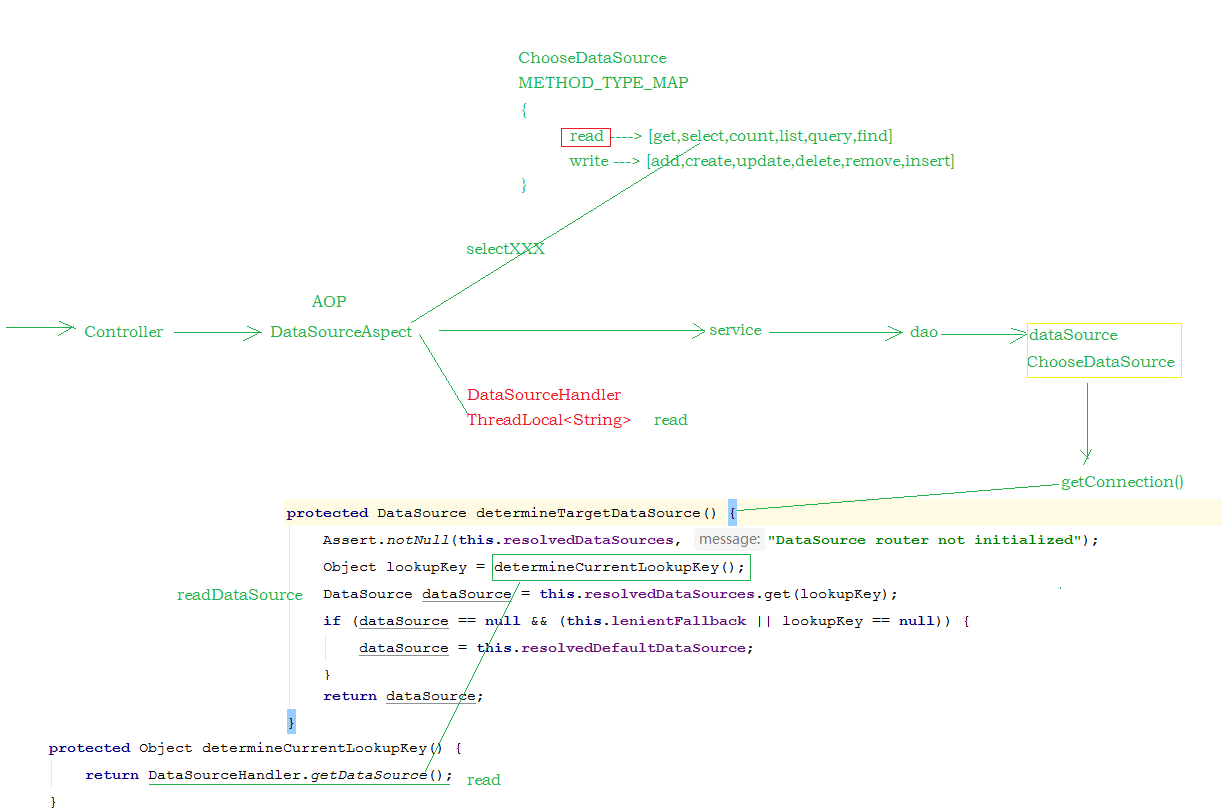
4.12 性能优化 - 应用优化
4.12.1 缓存
可以在业务系统中使用redis来做缓存,缓存一些基础性的数据,来降低关系型数据库的压力,提高访问效率。
4.12.2 全文检索
如果业务系统中的数据量比较大(达到千万级别),这个时候,如果再对数据库进行查询,特别是进行分页查询,速度将变得很慢(因为在分页时首先需要count求合计数),为了提高访问效率,这个时候,可以考虑加入Solr 或者 ElasticSearch全文检索服务,来提高访问效率。
4.13.3 非关系数据库
也可以考虑将非核心(重要)数据,存在 MongoDB 中,这样可以提高插入以及查询的效率。
